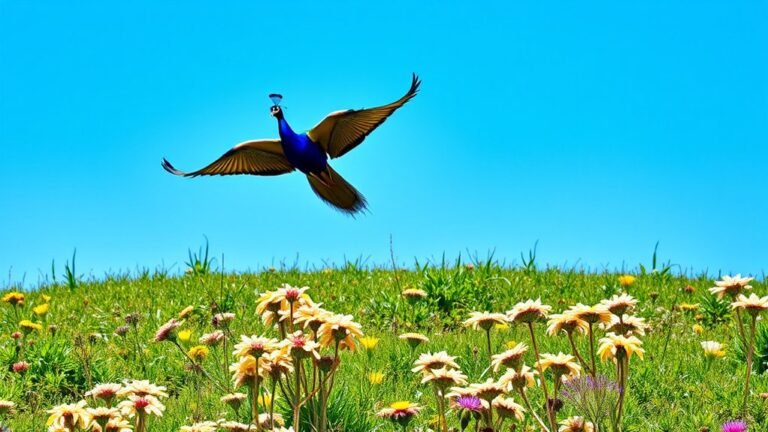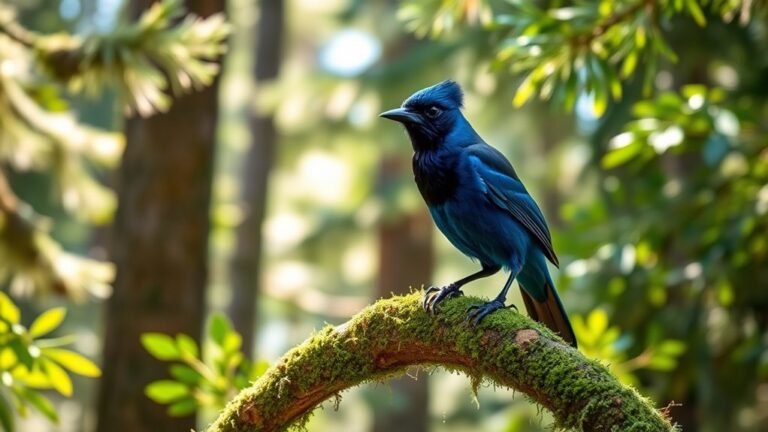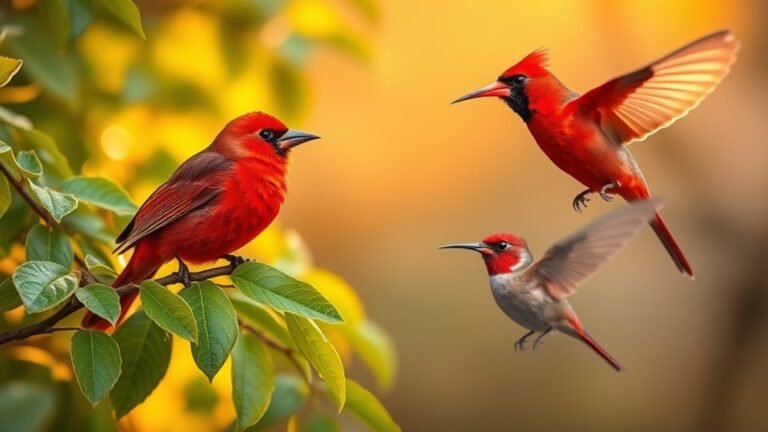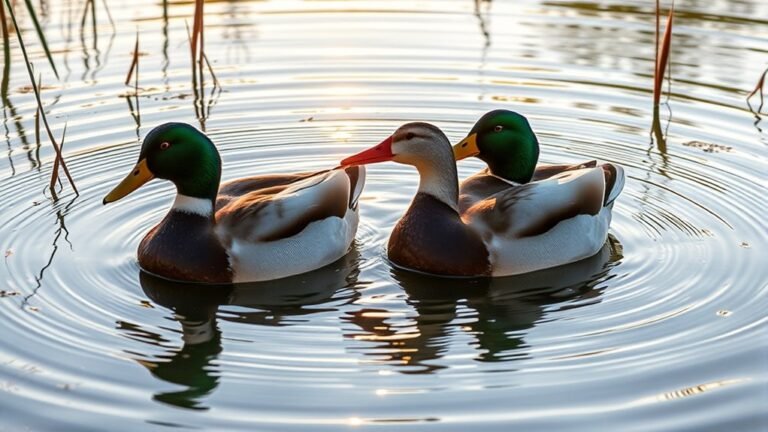The Female Peacock: Characteristics and Facts
When you look at a peahen, you see a quiet, lovely bird. She wears soft browns and tans that help her blend into her home. This makes her look plain next to the bright males. But don't let her simple colors fool you. She plays an important role in nature.
Peahens help keep their species alive. They are smart and know how to find food and stay safe. Watching a peahen can make you wonder about how animals adapt to their world. What else is going on with her beyond her calm surface?
Peahens may not show off like peacocks, but they are fascinating in their own way. Their everyday actions teach us a lot about survival. There is much to appreciate in her quiet strength and the part she plays in the ecosystem.
A Quick Overview
Peahens are the female peacocks. They are smaller and weigh between 6 to 13 pounds. Their feathers are soft shades of brown and tan. This helps them blend in with their environment, unlike the bright feathers of peacocks.
During mating season, peahens pick their mates based on how colorful the peacocks' displays are. Peahens also take care of their chicks. They lay four to eight eggs and keep them warm for 28 days until they hatch.
Sadly, peahens face threats from habitat loss. Urban development takes away the places where they live and breed. This makes their survival harder. Let's appreciate these beautiful birds and support their habitats!
Overview of the Peahen
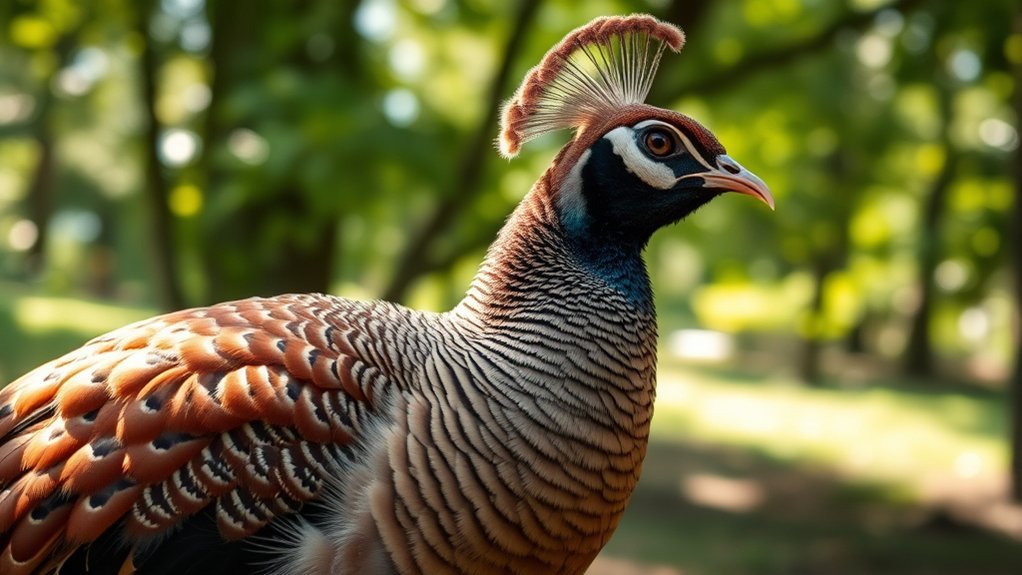
The peahen is the female of the peacock. She often goes unnoticed because she doesn't have the bright colors that peacocks do. But she plays an important role in the family.
Peahens choose their mates carefully. They watch the peacocks show off their colorful feathers. This helps them pick a strong mate to have healthy babies. When peahens bond with a peacock, they take care of their young together. Peahens are patient and protective mothers.
Even though peahens aren't as colorful, their brown feathers help them blend into their surroundings. This is very important for staying safe in the wild.
Appreciating peahens reminds us that every animal has its own special role. Each one is important, even if it isn't always easy to see at first.
Distinct Plumage of the Female Peacock
Peahens have a special look that's very different from the bright peacocks. While peacocks show off their colorful feathers, peahens wear softer colors. Their feathers help them hide in nature, making them hard to spot.
Here are some easy-to-see facts about their plumage:
- Peahens are mostly soft browns and tans. These colors help them blend into the ground.
- Their feather patterns are unique and delicate, unlike the flashy peacock feathers.
- They look graceful, but their beauty is often missed because it's so subtle.
- The muted colors of their feathers keep them safe, especially when they're nesting.
- Overall, peahens show a gentle and caring side of nature.
Peahens may not shine as brightly as peacocks, but they've their own kind of beauty that's really worth noticing!
Size and Physical Differences From the Male
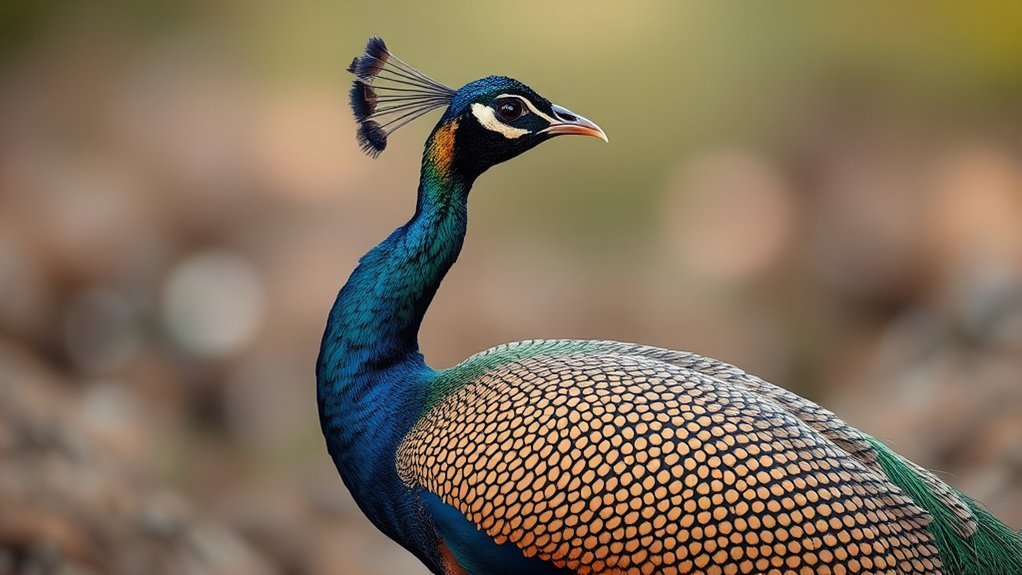
Peahens and peacocks look quite different, especially when you check their size and appearance. Peahens are smaller. They usually weigh between 6 and 13 pounds. In contrast, peacocks can weigh anywhere from 13 to 20 pounds. This size difference helps peahens stay quick and agile.
When it comes to their looks, peahens have softer and more muted colors. They mostly have shades of brown and tan, which helps them blend into their surroundings. Peacocks have bright and colorful feathers. Their long tail feathers are famous for being shiny and eye-catching, while peahens have shorter tail feathers that aren't as flashy.
These differences show how peahens and peacocks play different roles in nature. Each has special traits that help them survive and thrive in their own way. Peahens are unique and are a valuable part of the peafowl family.
Behavior and Social Structure
Peahens, the female peacocks, are interesting creatures. They've their own ways of living and getting along with each other.
Let's look at how they behave and work together.
- Peahens like to form groups but not always tight ones. They often hang out with others but keep some distance.
- They've a pecking order. The older and more experienced peahens usually have the upper hand.
- When it comes to mating, peahens pay attention to the males' colorful displays. They choose carefully who they want to mate with.
- Peahens communicate with each other, especially when they're ready to mate.
- While looking for food, they also keep an eye out for dangers, like predators.
These behaviors help peahens stay safe and work well with their group.
Watching peahens can be fun and shows you how they interact and help each other in their communities.
Nesting and Reproductive Habits
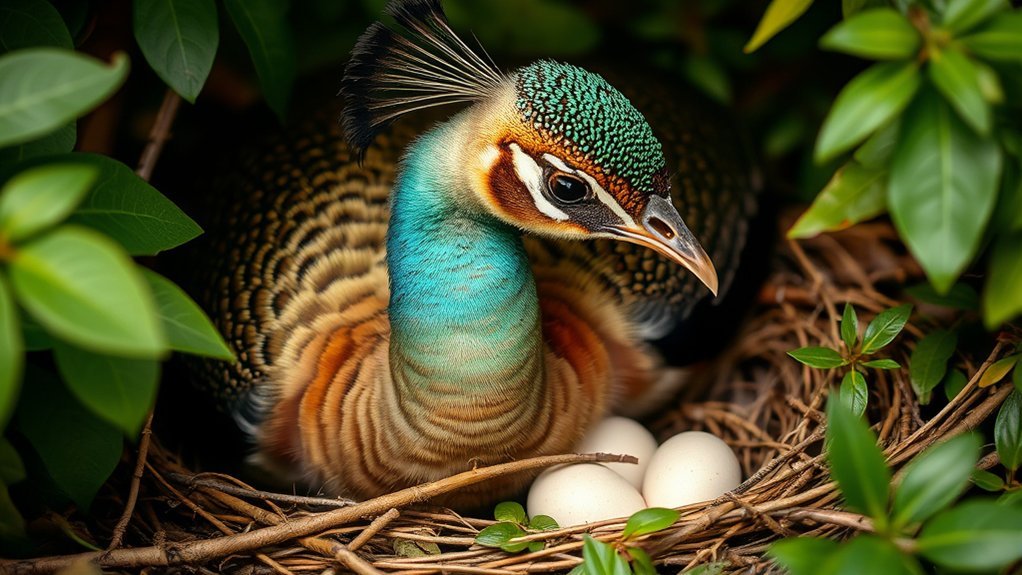
Peahens, which are female peafowl, show interesting nesting and reproductive habits. When a peahen is looking for a place to build her nest, she chooses carefully. She likes spots with thick plants that can shield her eggs from animals that might want to eat them or other dangers in the environment.
Peahens usually lay about four to eight eggs and keep them warm for around 28 days until they hatch.
After the chicks are born, peahens work hard to take care of them. They help their little ones find food and stay safe. This strong bond between a mother peahen and her chicks helps them feel like they belong in their community.
The Role of the Peahen in Survival
Peafowl need peahens to survive. The peahen plays a big role in taking care of her babies and keeping them safe. Here are some important things she does:
- The peahen finds good places to build her nest. She makes sure the nest is safe from animals that might want to eat her eggs or chicks.
- She hides her eggs well. This helps keep them safe and makes it harder for predators to see them.
- When her chicks hatch, she protects them fiercely. She'll scare off any threats to keep her little ones safe.
- After the chicks are born, she shows them where to find food. This helps them learn how to eat and find their own meals.
- Peahens often stick together with other birds. This group helps keep everyone safe as they look out for danger.
The peahen's hard work is important for helping peafowl survive in the wild.
Vocalizations and Communication
Peacocks are known for their bright feathers, but peahens, the female peafowl, have their own way of speaking. They make different sounds that mean different things. Some sounds are soft and sweet, while others are sharp and loud.
Peahens use these sounds to tell others when they're scared or to help their chicks find them. During mating season, they make special calls to attract male peacocks. These calls show they're ready to mate.
The different sounds peahens make can tell us how they feel. By listening closely, you can learn more about how these birds interact. This can help you feel more connected to nature.
Diet and Foraging Habits
Peahens have interesting voices, and understanding them can help you see how they find food. These birds like to eat several kinds of food to stay healthy.
When you watch how they look for food, you can see they're good at it.
Peahens eat:
- Seeds and grains
- Insects and larvae
- Fruits and berries
- Leaves and flowers
- Small reptiles and amphibians
You will often see peahens working together as they look for food. This is a fun part of their social life.
They've sharp eyes that help them find tasty snacks. By learning about their eating habits, you can connect better with these amazing birds and see how they fit into nature.
Predation and Self-Defense Strategies
Peahens have to watch out for many predators in the wild. To stay safe, they use some smart tricks. One main trick is camouflage. Their feathers help them blend in with the leaves and bushes where they like to rest.
When they feel threatened, peahens are very alert. They can spot danger from both the sky and the ground. If they see something scary, they might freeze or crouch down low. This helps them stay hidden.
If a peahen senses real danger, she'll calmly walk away to find a safer spot. This way, she avoids getting too close to predators. By using these simple strategies, peahens can survive better in their homes.
They show us how well they adapt to stay safe in the wild.
Cultural Significance of Peahens
Peahens are special birds that hold important meanings in many cultures around the world. People often see them as symbols of beauty, love, and safety. They appear in stories and art, showing how much people appreciate them.
In many cultures, peahens stand for caring and being a good mother.
In Hinduism, the peahen is linked to the goddess Saraswati, who's all about learning and wisdom.
Artists like to draw peahens in beautiful settings with lots of nature, showing their connection to the earth.
Some cultures view them as signs of good luck and wealth.
Peahens also play a role in ceremonies that celebrate femininity and grace.
Conservation and Habitat Protection
Peahens are beautiful birds, but they face big problems. Their homes, like forests and wetlands, are disappearing because of activities like cutting down trees and building towns. This makes it hard for peahens to find places to nest and get food. As their habitats get smaller, their numbers go down.
We need to take action to help protect these amazing birds and their homes. By getting involved in conservation efforts, we can work together to keep peahens safe for the future.
This not only helps the peahens, but it also brings people together who care about nature and want to make a difference.
Let's join forces to protect these wonderful creatures and the places they live!
Frequently Asked Questions
Why Do Peahens Have Less Vibrant Colors Than Peacocks?
Peahens have dull colors compared to peacocks. This happens for a couple of reasons. First, male peacocks are very colorful. They show off their bright feathers to win the attention of female peahens. This helps them attract mates.
On the other hand, peahens are usually brown and gray. These colors help them blend in with their surroundings. When they're camouflaged, it's harder for predators to spot them. This camouflage keeps them safer, especially when they are raising their young.
How Long Do Peahens Typically Live in the Wild?
Peahens, which are female peacocks, usually live for about 15 to 20 years in the wild. They have a few smart tricks to help them survive. For example, they can blend in with their surroundings, which keeps them safe from predators. They also have sharp instincts and are very careful when they move around. By staying aware of their environment, they can avoid danger and live a longer life. It's fascinating how these birds adapt to stay safe!
Do Peahens Participate in Mating Displays?
Peahens don't show off like peacocks do. Peacocks spread their beautiful feathers to attract mates. But peahens still have their own way of showing interest.
During mating times, peahens do little things to catch a male's attention. They change their postures or make small movements. These actions help them seem more appealing to potential partners. So, while peahens might be quieter than males, they still play a role in the mating dance.
Can Peahens Recognize Individual Peacocks?
Yes, peahens can recognize individual peacocks. This means they can tell different peacocks apart. This skill helps them pick mates that have the traits they want. Choosing the right mate can help them have more babies.
What Threats Do Peahens Face in the Wild?
Peahens face some big challenges in the wild. One major threat is habitat loss. When people build homes and roads, they take away the places where peahens live and find food.
Another big risk for peahens is predators. Animals like foxes and eagles hunt them. This makes it hard for peahens to survive and have babies.

Luna is the passionate founder and author of Birds and You, a website dedicated to sharing her love for birds with fellow enthusiasts. Through her engaging articles and guides, she aims to educate and inspire others to explore the fascinating world of birds. When she’s not writing, you can find Luna observing birds in their natural habitats or sharing beautiful bird photography on Pinterest. Join her on this journey to celebrate and protect our feathered friends!




